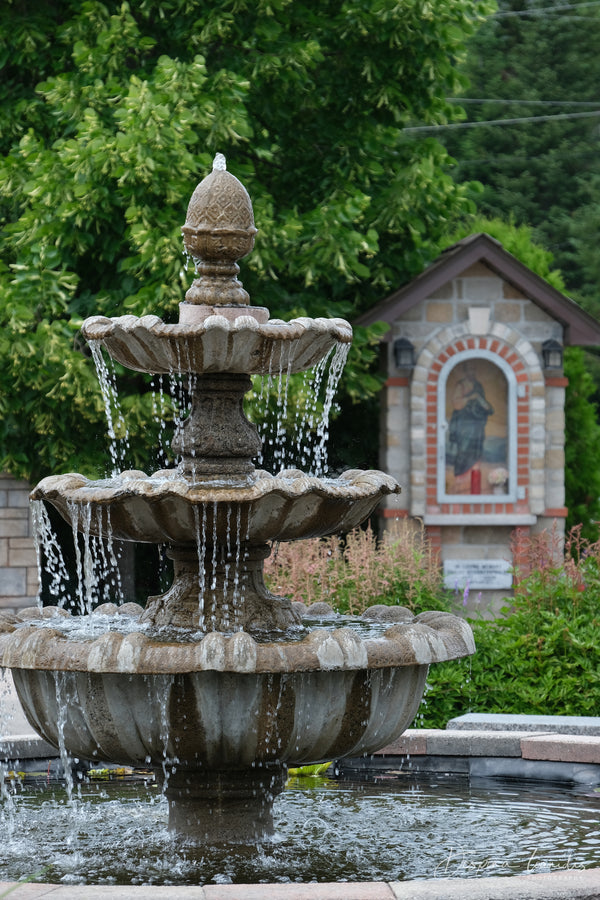The solemn days of Holy Week-Part II
The services of the first three days
Holy Monday, Tuesday and Wednesday: The first thing that must be said about these services, and most of the other services of Holy Week, is that they are "sung" in anticipation. Each service is rotated ahead twelve hours. The evening service, therefore, is actually the service of the next morning, while the morning services of Holy Thursday and Holy Saturday are actually the services of the coming evening. Understanding that, let's turn to the Services of Holy Monday, Tuesday and Wednesday (celebrated Palm Sunday, Monday and Tuesday evening). The services of these days are known as the Bridegroom or Nymphios Orthros Services. At the first service of Palm Sunday evening, the priest carries the icon of Christ the Bridegroom in procession, and we sing the "Hymn of the Bridegroom." We behold Christ, as the Bridegroom of the Church, bearing the marks of His suffering, yet preparing a marriage Feast for us in God's Kingdom. Each of these Bridegroom Orthros services has a particular theme.
On Holy Monday, the Blessed Joseph, the son of Jacob the Patriarch, is commemorated. Joseph is often seen as a Type of Christ. Joseph was betrayed by his brothers, thrown into a pit, and sold into slavery by them. In the same way, our Lord was rejected, betrayed by His own, and sold into the slavery of death. The Gospel reading for the day is about the barren fig tree, which Christ cursed and withered because it bore no fruit. The fig tree is a parable of those who have heard God's word, but who fail to bear the fruit of obedience. Originally the withering of the fig tree was a testimony against those Jews who rejected God's word and His Messiah. However, it is also a warning to all people, in all times, of the importance of not only hearing the God's word, but putting it into action.
The Parable of the Ten Virgins is read on Holy Tuesday. It tells the story of the five virgins who filled their lamps in preparation for receiving the bridegroom while the other five allowed their lamps to go out, and hence were shut out of the marriage feast. This parable is a warning that we must always be prepared to receive our Lord when He comes again. The theme of the day is reinforced by the exapostelarion hymn we sing: "I see Thy Bridal Chamber adorned, O my Savior, but have no wedding garment that I may enter. O Giver of Light, enlighten the vesture of my soul, and save me."
The theme of Holy Wednesday is repentance and forgiveness. We remember the sinful woman who anointed our Lord in anticipation of His death. Her repentance and love of Christ is the theme of the wonderful "Hymn of Kassiane" which is chanted on this night, reminding us one more time, before "it is too late," that we too may be forgiven if we repent.
Holy Unction: The Mystery or Sacrament of Holy Unction is celebrated on Holy Wednesday evening. Actually this service can be celebrated any time during the year, especially when one is ill. However, because of our need for forgiveness and spiritual healing, we offer this service during Holy Week for the remission of our sins. We should prepare for this service in a prayerful way, as we do for Holy Communion.
Holy Monday, Tuesday and Wednesday: The first thing that must be said about these services, and most of the other services of Holy Week, is that they are "sung" in anticipation. Each service is rotated ahead twelve hours. The evening service, therefore, is actually the service of the next morning, while the morning services of Holy Thursday and Holy Saturday are actually the services of the coming evening. Understanding that, let's turn to the Services of Holy Monday, Tuesday and Wednesday (celebrated Palm Sunday, Monday and Tuesday evening). The services of these days are known as the Bridegroom or Nymphios Orthros Services. At the first service of Palm Sunday evening, the priest carries the icon of Christ the Bridegroom in procession, and we sing the "Hymn of the Bridegroom." We behold Christ, as the Bridegroom of the Church, bearing the marks of His suffering, yet preparing a marriage Feast for us in God's Kingdom. Each of these Bridegroom Orthros services has a particular theme.
On Holy Monday, the Blessed Joseph, the son of Jacob the Patriarch, is commemorated. Joseph is often seen as a Type of Christ. Joseph was betrayed by his brothers, thrown into a pit, and sold into slavery by them. In the same way, our Lord was rejected, betrayed by His own, and sold into the slavery of death. The Gospel reading for the day is about the barren fig tree, which Christ cursed and withered because it bore no fruit. The fig tree is a parable of those who have heard God's word, but who fail to bear the fruit of obedience. Originally the withering of the fig tree was a testimony against those Jews who rejected God's word and His Messiah. However, it is also a warning to all people, in all times, of the importance of not only hearing the God's word, but putting it into action.
The Parable of the Ten Virgins is read on Holy Tuesday. It tells the story of the five virgins who filled their lamps in preparation for receiving the bridegroom while the other five allowed their lamps to go out, and hence were shut out of the marriage feast. This parable is a warning that we must always be prepared to receive our Lord when He comes again. The theme of the day is reinforced by the exapostelarion hymn we sing: "I see Thy Bridal Chamber adorned, O my Savior, but have no wedding garment that I may enter. O Giver of Light, enlighten the vesture of my soul, and save me."
The theme of Holy Wednesday is repentance and forgiveness. We remember the sinful woman who anointed our Lord in anticipation of His death. Her repentance and love of Christ is the theme of the wonderful "Hymn of Kassiane" which is chanted on this night, reminding us one more time, before "it is too late," that we too may be forgiven if we repent.
Holy Unction: The Mystery or Sacrament of Holy Unction is celebrated on Holy Wednesday evening. Actually this service can be celebrated any time during the year, especially when one is ill. However, because of our need for forgiveness and spiritual healing, we offer this service during Holy Week for the remission of our sins. We should prepare for this service in a prayerful way, as we do for Holy Communion.

